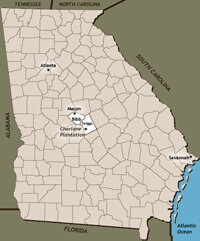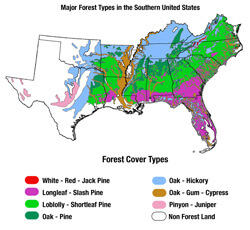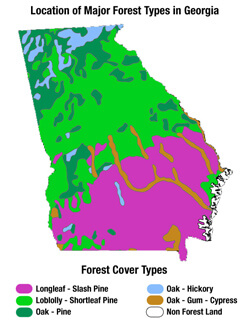Overview
 |
This essay examines two spaces dear to musician and conservationist Chuck Leavell. In Part One, Leavell discusses forest management on a small portion of his property in Twiggs County, Georgia. In Part Two, he performs solo piano pieces at the historic Douglass Theater in downtown Macon, Georgia.
Family Forestry
Live in Macon
On December 3, 2004 Chuck Leavell performed a solo piano concert at the historic Douglass Theatre in downtown Macon, Georgia. Included here are three songs, a standard blues and two instrumentals composed by Leavell.
About Chuck Leavell
In 1967, when he was fifteen, Alabama-native Chuck Leavell made his way to Muscle Shoals, Alabama's legendary studios where he played on several records, including Freddy North's soul classic "Don't Take Her, She's All I've Got." In 1969 Chuck moved to Macon, Georgia, where southern music impresario Phil Walden had recently opened Capricorn Records and studio. There he joined Alex Taylor's (brother of James Taylor) band Friends and Neighbor for a year and a half and appears on his Capricorn album, Dinnertime. Next, Leavell spent six months on the road with Dr. John (Mac Rebennack). He refers to his time with Dr. John as his "college education," watching and listening to a master at work.
In 1972, after the death of Duane Allman and prior to the death of Berry Oakley, Leavell, barely twenty, was asked to join the Allman Brothers Band on piano and electric piano. The first album he recorded with the band was Brothers and Sisters, which hit number one on Billboard's Pop charts and included "Ramblin' Man" and "Jessica." Leavell recorded two more albums before the Allmans disbanded. Emerging from the break-up with his rock/jazz/blues fusion group Sea Level, the band toured heavily during the late 1970s and released five albums.
Catching the ears of and becoming friends with the late rock 'n' roll impresario Bill Graham and keyboardist Ian Stewart, the original "sixth" Rolling Stone, in 1982 Leavell was invited to assume a significant keyboardist/vocalist role for the Stones. "Chuck is our direct link to Stu," says guitarist Keith Richards. "Without that continuity, the Stones would not be the Stones." Leavell describes his role with the Stones as a "musical navigator" who keeps track of arrangements and keeps things balanced in addition to spicing up the music with his keyboards.
In addition to solo projects and working with Stones members and their various projects, Leavell is an in-demand session player and producer. His credits include recordings by Gregg Allman, Chuck Berry, the Black Crowes, Blues Traveler, Larry Carlton, Eric Clapton (notably, the Grammy-winning Unplugged album), Aretha Franklin, George Harrison, Warren Haynes and Gov't Mule, John Hiatt, the Indigo Girls, Train, Dave Edmunds, Dion and other artists.
His musical portrait, Southscape, was released in August of 2005. The nine tracks include eight new songs written or co-written by Leavell and a re-visitation of "Jessica". In addition to musical recording and touring, Leavell manages his pine forested Charlane Plantation located in Twiggs County, Georgia. To help shape policy and to promote sound forestry management practices in the United States, Leavell published Forever Green: The History and Hope of the American Forest (2001). He also speaks to a variety of groups and meets with environmental officials in Washington. He and his wife Rose Lane were named National Outstanding Tree Farmers of the Year in 1999.

About the Compilers
This essay represents the efforts of several people who worked individually and collectively over many months to bring this piece together. Steve Bransford filmed and edited the three forestry pieces featuring Chuck Leavell over the course of four years; filmed and edited Peacock's Portable Saw Mill; edited the 1960s era footage; and, along with Sarah Toton, made the forestry maps using USGS data and ESRI shapefiles.
About the Douglass Theatre
Macon native Charles Henry Douglass, an African American entrepreneur, opened the Douglass Theatre in Macon in 1912 to serve Macon's African American community. The original theater was located at 363 Broadway until 1921 when it moved into a larger space next door at 355 Broadway. The new facility accommodated seven-hundred fifty to eight hundred patrons and quickly became the hub of African American entertainment in Macon. As the premiere African American performance venue in segregated Macon, the Douglass Theater operated as a movie house and a center for live entertainment, including vaudeville and eclectic musical acts. Ma Rainey, Bessie Smith, Duke Ellington, Little Richard, James Brown and Otis Redding all graced the stage of the Douglass. Upon the death of Charles Henry Douglass' son Peter in 1973, the theater closed. The building was eventually purchased by the city of Macon in 1978 and after an extensive renovation, the Douglass Theater on January 11, 1997 and continues to show films and host live entertainment.
Recommended Resources
Videos
Demonstration of Portable Saw Mill, https://vimeo.com/126311270.
Hill Brothers Short Log Harvesting, https://vimeo.com/126196928.
Hill Brothers Long Log Harvesting, https://vimeo.com/126196817.
Maps
About Twiggs and Bibb Counties: Geography, History, Demography
Bibb and Twiggs counties are located in middle Georgia in the Fall Line Hills district of the state. They lie at the northern boundary of the Sea Island and East Gulf Central Coastal Plain, where the Georgia Piedmont meets the Coastal Plain. The landscape is characterized by small rolling hills and flat plains, with the Ocmulgee River running through the city of Macon and carving the western border of Twiggs County. Interstates 16 and 75 are these counties' two major transportation arteries. According to 2000 census data, the populations of Bibb and Twiggs counties differ significantly. Bibb County is home to more than 150,000 residents, two-thirds of whom live in Macon, the sixth-largest metropolitan area in Georgia. Rural Twiggs County, however, has approximately 11,000 residents, with only around 1,200 living in Jeffersonville, the county seat and its largest town.
Although the two counties lie side by side, their historical demographics could paint contrasting portraits. Substantial changes in each county's population occurred at different times over the past century. Due to the emergence of Macon as an urban industrial center, Bibb County has grown dramatically, adding around 100,000 residents, with the largest increase coming after the end of both the First and Second World Wars, and during the 1950s and 1960s. While agriculture remains a constant presence in Bibb County, Macon itself has shifted towards a service economy, with most employment found in retail and service industries, health care, financial and insurance services, and tourism. Macon is home to Mercer University and Wesleyan College, the oldest women's college in the United States.
Twiggs County has a population only thirteen percent of that of Bibb, with the majority of its residents living in rural areas and engaged in some form of agribusiness. Twiggs' population has decreased after each world war and even further during the postwar era of the fifties and sixties, falling from 9,117 residents in 1940 to 7,935 residents by 1970. The present population of the county is comparable to that of the 1910s. Furthermore, the 2000 census indicated that Jeffersonville experienced a 21.7 percent decrease in population in the decade since the 1990 census.
The racial demography of both counties indicates that whites constitute the majority of the population, but this was not always the case. Both Bibb and Twiggs counties were part of the Southern plantation economy. During the antebellum era, Twiggs County had larger farms and a higher number of slaves per farm as compared to Bibb County. From 1850 to 1860, the percentage of the slave population in Bibb County decreased significantly, likely due to the 1850s cotton boom, which simultaneously supported a 60% increase in Macon's white urban population and caused a rural demand for black fieldhands on surrounding plantations like those in Twiggs County. The historical racial demography indicates that during the 1860 Census, Twiggs County was home to 2,930 whites, 72 freedmen, and 5,318 slaves. Ten years later, after Civil War and Emancipation, the white population remained relatively consistent at 2,913 residents, while the black population increased 4 percent to 5,632. A century later, the 1960 census indicated that 3,164 whites lived in Twiggs County, about an 8 percent increase from the 1860 census, whereas the county experienced an 11 percent decrease in its African American population over that same period, with 4,771 residents.
As of the 2000 census, 50.1 percent of Bibb County residents are white, 47.3 percent are African American, and 1.3 percent are Latino. In Macon, 62.5 percent of the population is African American, 35.5 percent is white, and 1.2 percent is Latino. By comparison, 54.9 percent of Twiggs County residents are white, 43.7 percent are African American, and 1.1 percent are Latino. While the Latino population is well below the state average of 5.3 percent, the African American population of both counties exceeds the state average (28.7 percent) and the white population falls below the state average (65.1 percent). Poverty grips Bibb and Twiggs counties with nearly one in five of either county's residents living below the poverty line.
Percentage of Residents Below the Poverty Line
|
Year
|
Twiggs
|
Bibb
|
State
|
National
|
|
1989
|
19.5%
|
20.3%
|
14.65%
|
13.1%
|
|
1999
|
19.7%
|
19.1%
|
13.0%
|
12.4%
|
The median household income in Bibb County according to the 2000 census was $34,532, which was up from the $25,474 average income measured in 1990. By comparison, Twiggs County's 2000 average was $31,608, a significant increase from the 1990 average of just $19,213.
Median Household Income
|
Year
|
Twiggs
|
Bibb
|
State
|
National
|
|
1989
|
$19,213
|
$25,474
|
$38,536
|
$41,138
|
|
1999
|
$31,608
|
34,532
|
$42,433
|
$41,994
|
The county's poverty is placed in even bolder relief when considering its two largest centers of population. Between 1970 and 2000, the poverty levels among individuals living in Macon fluctuated from 22.5 percent in 1970; to 22.4 percent in both 1980 and 1990; to a 25.5 percent level in 2000, meaning that one in four people living in Macon live below the poverty line. During that same period, the city's median household income decreased from $28,209 in 1970; to $29,830 in 1980; to $28,266 in 1990; to $27,405 in 2000. In Jacksonville, between 1980 and 2000, the poverty level increased from 23.1 percent in 1980 to 35.9 percent in 1990, then fell to 21.4 percent in 2000. The median household income in Jeffersonville measured over the last three censuses indicates a $26,980 average in 1980; down to $22,792 in 1990; and back up to $25,000 in 2000.
Whereas Georgia has proven a consistently Republican state on the Electoral College map since the 1980s, both counties have voted majority Democrat in the last four presidential elections, though those majorities have decreased with every cycle. In 2004, John Kerry won slim 50.74 percent and 50.81 percent majorities in Bibb and Twiggs counties, respectively, which was down from Bill Clinton's 51.9 percent Bibb majority and 61.8 percent Twiggs majority in the 1992 election. Whereas his father garnered only 36.7 percent of the vote in Bibb County and 25.1 percent in Twiggs County in 1992, George W. Bush won 48.6 percent and 43.4 percent of the vote in Bibb and Twiggs, respectively, in 2000; and 48.64 percent in Bibb and 48.34 percent in Twiggs in 2004. As state politics go, in the 2002 gubernatorial election, Bibb and Twiggs were among only 37 of Georgia's 159 counties where the incumbent Democratic governor Roy Barnes won majorities over Sonny Perdue, the first Republican to win that office since Reconstruction.
Bibb County covers a total area of 255 square miles and Twiggs County 363 square miles. As of 2002 USDA figures, less than one percent of the land in either county is devoted to crops, with 9,193 acres used in Bibb and 11,721 acres in Twiggs, though cropland has decreased significantly in Bibb County by approximately 3500 acres since 1987 due to commercial development. Alfalfa, hay, sorghum, grain, and soybeans are the major cash crops grown in Bibb County, while cotton dominates agricultural production in Twiggs County, followed by alfalfa, hay, peanuts, and smaller acreages of wheat and corn. Twiggs County sits in the heart of the so-called "Kaolin Belt," a thirteen county area in middle Georgia stretched between Macon and Augusta, where this white clay mineral is mined. Kaolin is used for any number of products from filler in plastics and rubber compounds, ceramics, pigment in paints, pharmaceuticals, and papermaking. 3,797 acres in Twiggs County service 36 kaolin mines where both kaolin and sand are extracted. Traditionally, kaolin mining has served as the primary industry in Twiggs County; but increased kaolin mining in China and Brazil, in addition to depleted kaolin deposits in middle Georgia due to decades of extraction, have contributed to a smaller-scale industry. Forestry also makes up an important part of Twiggs County agribusiness. The Fall Line (referred to colloquially as "The Gnat Line") also marks the dividing line/ boundary between two types of timber grown, the Longleaf Pine, which grows north of the Fall Line and the Loblolly which grows to South of the Fall Line into the Coastal Plain area.
Music
Music has been an integral part of Macon’s history. In the 1920s and 1930s, Macon was a standard stop on the touring itineraries of major African-American musicians, including Ma Rainey, Bessie Smith, and Duke Ellington. In the 1950s and 1960s, the city played an important role in the development of rhythm and blues, rock n’ roll and soul music. Little Richard was born in Macon, and Otis Redding grew up there, dropping out of high school to join Little Richard’s band, The Upsetters. The music scene in Macon helped accelerate the transition towards integration in the city by encouraging the breakdown of racial barriers at venues like the City Auditorium. The town also played a significant role in the history of seventies’ rock. Capricorn Records was formed in Macon in 1971 and enjoyed mainstream success with albums by The Allman Brothers Band and other Southern rock bands. In 1996 the Georgia Music Hall of Fame opened in Macon and has become a popular tourist attraction honoring the state’s rich musical history.
Links
Douglass Theatre Official Website, http://www.douglasstheatre.org/.
The Blues, Black Vaudeville, and the Silver Screen, 1912–1930s: Selections from the Records of Macon's Douglass Theatre, http://dlg.galileo.usg.edu/douglass/.
Kim Severson, "Forest Ranger Hat for a Rolling Stones Sideman," New York Times, February 27, 2012,
http://www.nytimes.com/2012/02/28/us/chuck-leavell-rock-keyboardist-named-honorary-forest-ranger.html.

